If you love the sharpest flavor of horseradish, you should not ignore this issue. This is because knowing whether horseradish goes bad or not allows you to have a smart decision to keep or toss out horseradish stored for a long time in your kitchen.
Or sometimes, you go to the market to purchase horseradish, but you do not know how to choose the freshest ones for your dishes.
All of your queries about storing horseradish will be met in this article! After going through what I am going to share, you will know whether horseradish goes bad, how to store its various types, and awesome tricks of preparing horseradish.
Can Horseradish Go Bad?
The answer is “yes”. As a fresh vegetable, horseradish becomes ruined over time with changes in its appearance, taste, and smell.
However, how well you can store the horseradish will determine its shelf life.
Hence, keep reading this post to discover proper preserving methods to extend the period of time horseradish can last before it starts ruining.
What Is Horseradish?
Horseradish is assumed to have its origin in Europe. It is from the cabbage family like wasabi, broccoli, or mustard. Its shape comes with a long root in white and green leaves.
This root has a spicy taste and is used as a spice added to dishes, especially roasted beef and steak, to spice them up.
Although horseradish’s flavor is quite distinctive, it’s an ideal substitute for many ingredients. Need a galangal alternative? Go for horseradish! What about replacements for dry mustards? Horseradish is one of your best bets! Truly, this spicy root is exceptionally versatile.
In addition, multiple compounds found in horseradish are beneficial for human health (1). Isothiocyanates and glucosinolates contained in horseradish can help people avoid bacteria (2), fungi (3), and cancer effects (4).
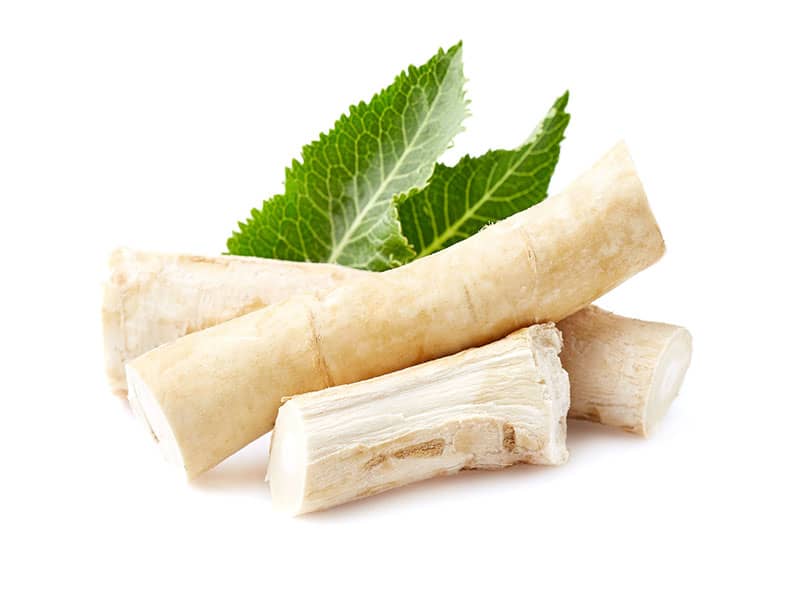
When using horseradish, you have three options to choose from. This depends on which one you prefer and fits well with your recipes: fresh horseradish roots, homemade horseradish sauce (commonly seen as mussels’ side dish), and prepared/ store-bought horseradish.
Horseradish Expiration Comparison Chart
The table below provides you with information on how long each type of horseradish can last:
“–” means that this form of horseradish cannot be stored well in the mentioned place.
* All the numbers in the table are just estimated, while the authentic life of horseradish relies on how effectively the horseradish is stored.
Fresh Horseradish
A whole fresh horseradish preserved well in the fridge can last up to 2 months. However, if you cut it out, the chopped horseradish will soon lose its flavor and pungency and should be eaten within a week before it turns to darken colors.
Prepared Horseradish
When buying horseradish sauce from the store, you should check its expiration date carefully to grab the newest one. It is because the new horseradish sauce always brings to your recipes a fresher flavor than the old one.
In addition, if you do not look at this date before purchasing the product, it may expire before meeting your needs in the future. It is better for you to consume the product within a couple of months before its flavor diminishes too much.
Homemade Horseradish Sauce
Just like store-bought horseradish sauce, the flavor of horseradish made at home will begin diminishing over time. In addition, homemade horseradish sauce with vinegar can last longer than one that contains mayonnaise or cream.
How To Tell If Horseradish Goes Bad?
There are different signs that help you identify the spoilage in various forms of horseradish.
Fresh Horseradish
When you shop raw horseradish roots from the store, you should choose firm roots rather than moldy, dry, or wrinkle ones that are the signs of poor quality horseradish.
If you see horseradish in your kitchen soft and mushy in a darker color, it’s time to toss them out and invest money for new ones.
However, with small black spots appearing on the horseradish peel, you can remove them and consume the rest.
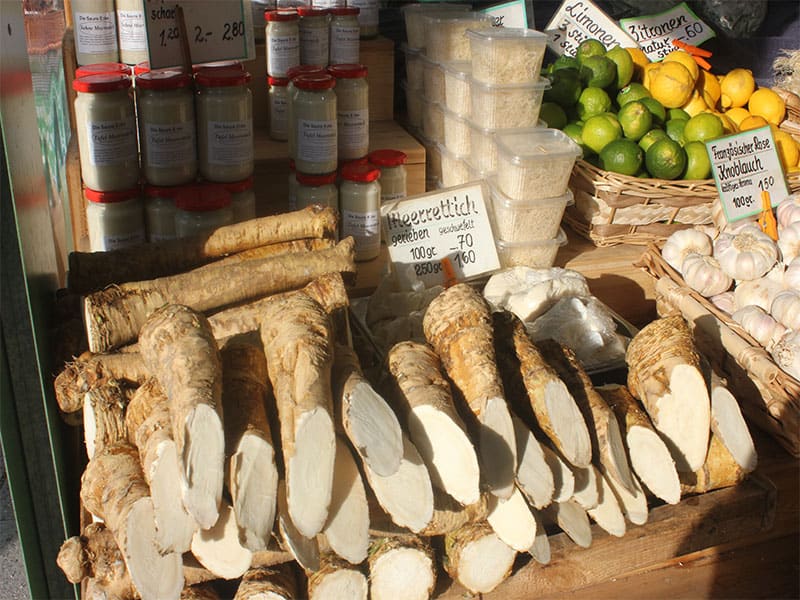
Store-Bought Or Homemade Horseradish
The spoiled horseradish sauce will change to another color and have a mold appearance or bitter taste. Therefore, discard it right away if you notice these signs of spoilage.
In addition, you can taste the sauce to know if its flavor is still ok to serve. If not, throw it away
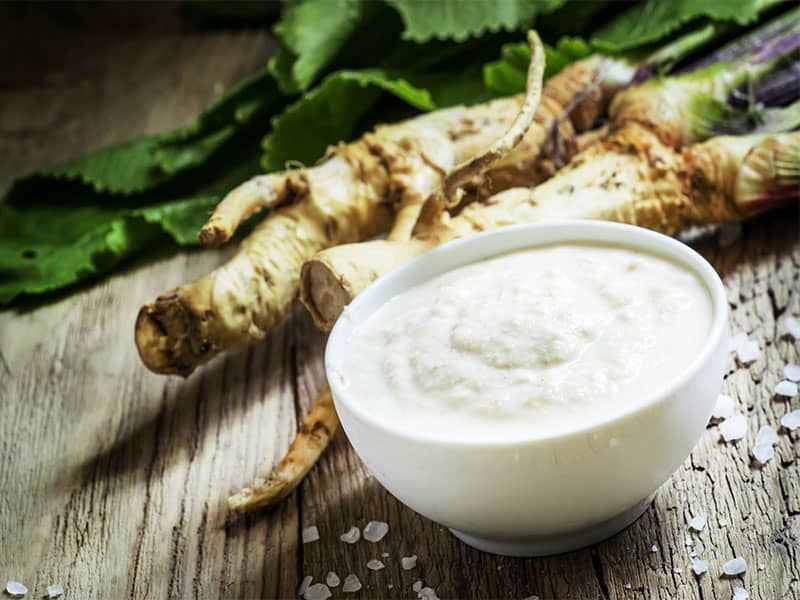
Should I Consume Too Old Horseradish?
I suggest that you should not consume horseradish that undergoes a long time of preservation and especially those past their expiration date for several reasons. Firstly, horseradish will lose its pungency during the storing process. As a result, it will not taste as good as you desire and sometimes have a bitter flavor that may ruin your dishes.
Secondly, the nutritious values of horseradish will degrade and even lose completely, so it is meaningless to consume this low-quality stuff.
Thirdly, you may suffer from health issues when eating ruined horseradish:
Risks of Food Poisoning: That the horseradish is stored for a long time and sometimes past its expiration date is an ideal condition for mold development.
It is impossible for you to completely remove the mold out of the spoiled horseradish. Besides visible mold appearing in horseradish sauce’s surface or the roots’ skin, lots of molds developing deeper inside can not be seen by human eyes.
In case you do not notice this problem and eat moldy horseradish, the results will be food poisoning.

Stomach-Related Issues: Your stomach health will be affected negatively if you consume expired horseradish. To be more specific, the bitter and mushy taste of low-quality horseradish would cause stomach irritations.
Hence, you should discard the horseradish with signs of spoilage to protect your health.

How To Store Horseradish?
Storing horseradish in proper ways plays a crucial role in prolonging its shelf life. Refer to the following awesome methods to deal with different kinds of horseradish.
Horseradish Root
You need suitable places to store and keep the freshness of raw horseradish.
In The Pantry
Like storing other fresh vegetables, in order to preserve raw horseradish, you can wrap it with plastic wrap or food-safe bags. Next, you make some holes on the wrap or bags to allow the airflow.
The horseradish stored in a dry and cool pantry or kitchen cabinet can last for a few days.
In The Fridge
To make the roots last longer, you can follow these steps to keep them in the fridge:
Step 1: Remove any spots appearing on the roots’ skin
Step 2: Wrap the roots doubly with paper towels
Step 3: Put the covered roots in a plastic bag with small holes for airflow that can keep the roots fresh.
Step 4: Pop the bag in the veggie drawer of the fridge
In Vinegar
With the grated or ground horseradish roots, storing them directly in the fridge is not a great option. This is because their flavor will soon fade away.
Therefore, I suggest you soak them in vinegar that will maintain the original flavor of horseradish. The vinegar plays the role of a natural preservative to maintain the quality of horseradish.
After that, you can store airtight jars of horseradish sauce in the fridge for future consumption. The vinegar with horseradish flavor will make your dishes truly different, especially in salad dressing or marinades.
In The Freezer
If you want to maximize the shelf life of horseradish roots up to 6 months, you can place them in the freezer. Although this method takes you some time and effort to do, the results will surprise you a lot.
There are some steps you should take for the preservation:
Step 1: Remove the horseradish roots’ skin and grate them into small pieces. This is an essential step to prevent the peel from sticking too much to the flesh of frozen horseradish.
Step 2: Divide the grated roots into different amounts to store and later thaw them easily.
Step 3: Use plastic wrap to cover portions individually, which will prevent the frosting effect on the food.
Step 4: Place the covered horseradish into the freezer.
Whenever you need frozen grated horseradish for meals, you add it directly to your dishes without defrosting it in advance.
Moreover, freezing is also an effective method for you to store whole roots. All you need to do is to place the whole roots without peeling into bags that are capable of vacuum sealing.
The frozen roots in vacuum conditions can last for months. Finally, just thaw the roots when you want to use them.
Would you like to access visible guidance for the horseradish preserving methods? If yes, click on this video.
In The Sand
To take this method of preserving raw horseradish, you first prepare a dark box with a thick layer of sand inside. Next, you bury the roots into the sand and pop the container in your cellar.
This storing method can prevent the roots from exposing heat, moisture, and sunlight that can damage the roots’ texture and lead to bacteria and mold activity.
However, in comparison to storing the horseradish in the fridge or freezer, this method maintains the horseradish’s freshness in a shorter period of time.
If you want to know more about this simple storing method, you can click on this video.
In The Earth
It seems weird to leave the roots under the ground for preservation, but it truly works. Storing fresh horseradish roots in the soil is a traditional method usually applied by gardeners.
To do this, you dig a hole in your garden and then bury the roots in it. But the only weakness of this method is that you can not retain the freshness of roots for a long time.
Prepared Or Homemade Horseradish Sauce
Different from horseradish roots, the sauce comes with high liquid content. Hence, it will be more challenging to preserve it.
In The Pantry
The most ideal place to preserve store-bought jars of horseradish sauce is in the pantry or kitchen cabinet which usually comes in a dry and dark condition.
However, it does not apply with opened or homemade horseradish sauce that needs to be kept at a lower temperature to avoid the growth of bacteria and mold.
In The Fridge
The cool condition in the fridge not only weakens bacterial activity but also keeps horseradish sauce from air exposure. Therefore, it is a great place to store all types of horseradish sauce.
For the best preservation, you just remove it from the fridge when your recipes call for it and then put it back in the refrigerator right away after use.
The horseradish sauce can improve almost any dish’s taste. Prepare a dish with leftover roast beef and worry that it’s not fresh or tasty? Mix some horseradish with cream cheese and mustard for a lip-smacking sauce that will turn even a stale dish into a lip-smacking bite.
Do you know how to make horseradish sauce at home? If not, watch this video for a detailed guide.
Extra Tips and Advice
I give you some vital tips for storing and preparing horseradish.
1. Ensure cleanliness: Remember to use a clean spoon whenever you want to take out horseradish sauce for your recipes. Moreover, you need to wash your hands before touching the containers of horseradish sauce because any dirtiness will be a great opportunity for bacteria and mold infection that will soon make the sauce ruined.
2. Store the jars of horseradish upside down: In order to let the horseradish sauce maintain its freshness for a long time, you should place its jars upside down in the refrigerator.
To place the jar upside down, you should close the jar as tightly as possible. Don’t be afraid to seal the lid, as a good jar opener will help you open it with ease later. The important thing is that you need to make sure that there’s no way the liquid inside can leak out and make a mess.
3. Be cautious when making horseradish sauce at home: Due to the spiciness and heat of horseradish that may cause irritations in your skin, eyes and nose, you need to keep in mind important points when preparing horseradish roots:
FAQs
I also provide you with explanations of the common issues related to horseradish that you would be concerned about.
Consume The Horseradish As Soon As Possible!
To ensure that you can enjoy the most flavorful horseradish, you should purchase it enough for your needs to minimize the long-term preservation of the root or its sauce. Although discarding ruined horseradish is the ultimate option to protect your health, it is still a waste of money. Be a smart consumer!
If you have any tips or experience in storing and preparing horseradish, you can share them with me and everyone by commenting below this post. When finding what I share valuable, give me a like or share as a warm encouragement from you!
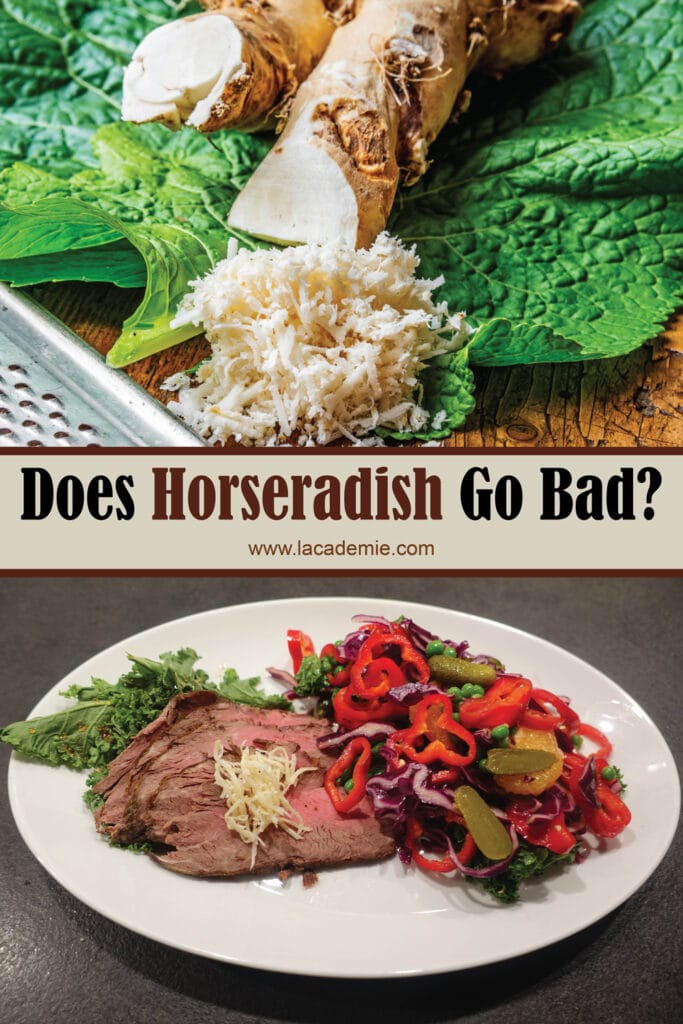
References
- Charles D.J. (2012) Horseradish. In: Antioxidant Properties of Spices, Herbs and Other Sources. Springer, New York, NY.
- IS;, P. H. W. C. K. D. S. (n.d.). Antimicrobial activity of isothiocyanates (ITCs) extracted from horseradish (Armoracia rusticana) root against oral microorganisms. Biocontrol science.
- Choi, K.-D., Kim, H.-Y., & Shin, I.-S. (2017, June 27). Antifungal activity of isothiocyanates extracted from horseradish (Armoracia rusticana) root against pathogenic dermal fungi. Food science and biotechnology.
- Royston, K. J., & Tollefsbol, T. O. (2015, February 1). The Epigenetic Impact of Cruciferous Vegetables on Cancer Prevention. Current pharmacology reports.
- A Little Dab of Horseradish Could Help Resist Cancer. College of Agricultural, Consumer & Environmental Sciences. (n.d.)


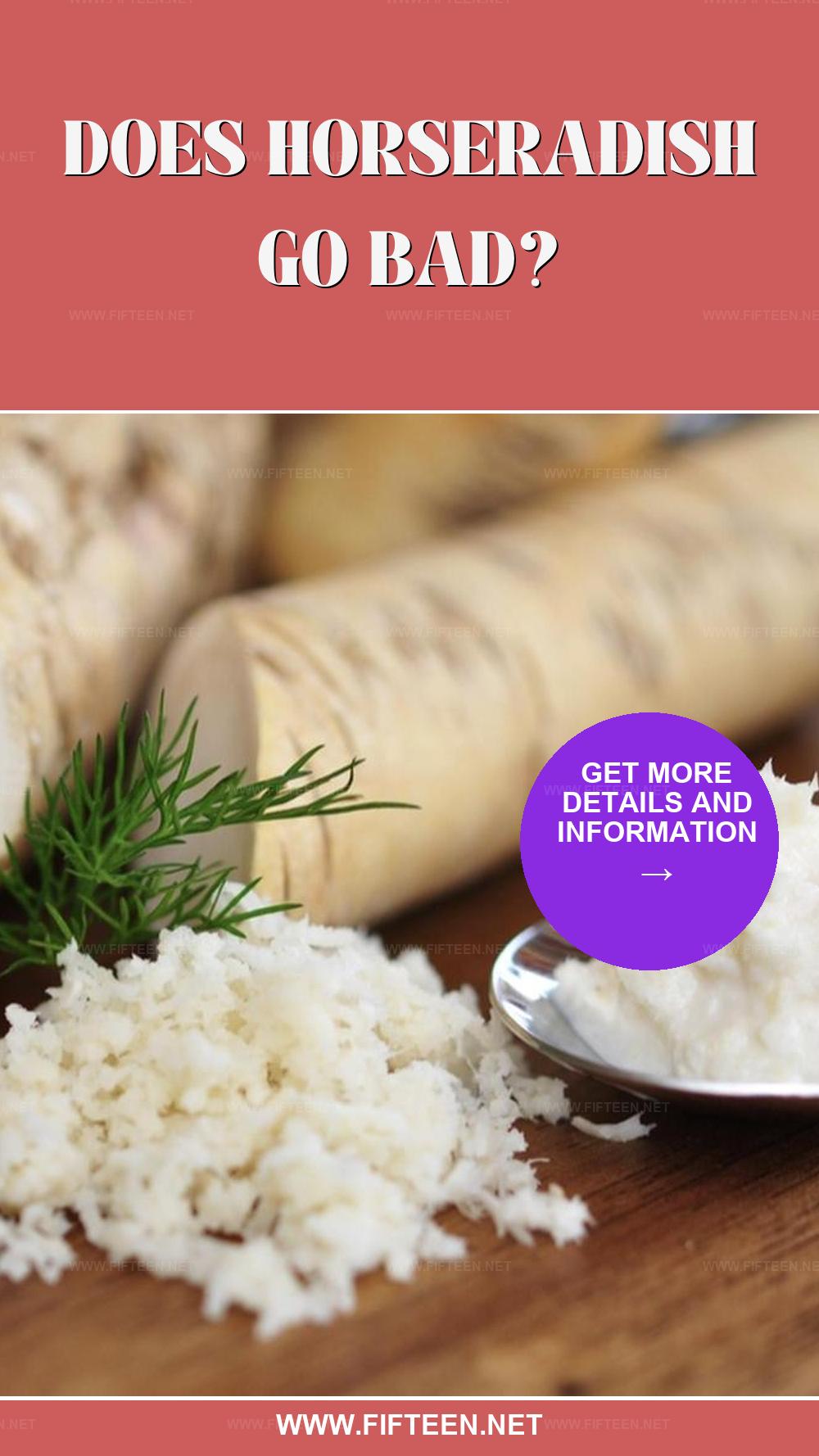
Jamie Scott
Editor in Chief, Senior Content Writer
Expertise
Home Cooking, Meal Planning, Recipe Development, Baking and Pastry, Food Editor, Cooking-video Maker, Western Food Evaluation Expert
Education
Le Cordon Bleu College of Culinary Arts
Local Community College, New York, NY
Jamie Scott is a skilled culinary expert and content creator specializing in Western cuisine. With over 15 years in the culinary field and formal training from Le Cordon Bleu, Paris, Jamie deeply understands how to blend nutrition with delicious flavors. His passion for cooking matches his commitment to making healthy eating accessible and enjoyable.
On Fifteen.net, Jamie brings a fresh perspective to classic dishes and beverages, offering readers insightful recipes, cooking tips, and a fresh view on meal planning that emphasizes taste, health, and simplicity.